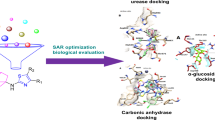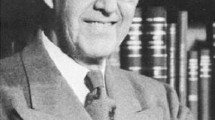Abstract
2,4-Dibromothiazole [orthorhombic, a = 6.700 (10), b = 16.21 (3), c = 5.516 (8) Å, space group Fmm2] shows a disordered crystal structure with molecules randomly oriented with respect to the direction of the Br–C(2)–N–C(2)–Br unit and the remaining ring atoms S(3) and C(3)H showing mixed occupancy. 2,4-Diacetyl-5-bromothiazole [triclinic, a = 4.040 (2), b = 8.254 (5), c = 13.208 (8) Å, α = 96.191 (17), β = 93.865 (16), γ = 94.067 (11)°, space group P-1] shows a structure dominated by halogen bonding, intramolecular between 4-COMe and 5-Br and intermolecular between 2-COMe of one molecule and 5-Br of the next.
Graphical Abstract
2,4-Dibromothiazole is disordered in the crystal structure with molecules randomly oriented either way round as shown. There is evidence for unusual intramolecular, and perhaps also intermolecular, halogen bonding between Br and C = O in the structure of 2,4-diacetyl-5-bromothiazole.

Similar content being viewed by others
Avoid common mistakes on your manuscript.
Introduction
Some time ago we reported the synthesis of 2,4-diacetylthiazole 1, a compound of interest for its flavour and aroma properties, by bromination of diethylthiazole 2 to give 3 followed by treatment with silver nitrate in aqueous ethanol (Scheme 1) [1]. In the course of this work, several new brominated thiazole derivatives were obtained, and we present here the X-ray structure determination of two of these of particular interest: 2,4-dibromothiazole 4 and 2,4-diacetyl-5-bromothiazole 6. Compound 4 was prepared as a potential alternative precursor to 1 using lithium/halogen exchange followed by acetylation with N-acetylmorpholine [2], but in agreement with the literature reports, even with two or more equivalents of reagents under a variety of conditions, this proceeded only once on the 2-position and the 4-positon was unreactive. The traditional synthesis of 4 requires treatment of the commercially available thiazolidine-2,4-dione 5 with a large excess of expensive POBr3 but we obtained it using the recently reported improved synthesis involving reaction of 5 with P2O5 and Bu4NBr in toluene [3]. In our reported synthesis of 1 [1], the bromination of 2 gave a range of other byproducts besides the desired tetrabromide 3. Treating the mixture with silver nitrate in aqueous ethanol gave mainly 1 and, as the most volatile component present, this was separated in pure form by vacuum distillation, but in only 49 % yield. If the crude mixture was instead subjected to column chromatography it allowed isolation of compounds 6 and 7, respectively derived from 8 and 9. There is therefore a competition between bromination at the 4-ethyl group and ring bromination at position 5 in 2 resulting in the observed mixture of three products. Compound 7 was obtained after distillation as a colourless liquid while compound 6 was recrystallised from hexane to afford a sample suitable for X-ray diffraction.
Experimental
2,4-Dibromothiazole 4
This compound was prepared by reaction of commercially available thiazolidine-2,4-dione 5 with P2O5 and Bu4NBr in boiling toluene [3]. It was obtained directly as colourless crystals suitable for X-ray diffraction which gave the following data: mp 81–82 °C (81.1–82.4 °C [3]; 1H NMR (CDCl3) δ 7.21 (1H, s); 13C NMR δ 120.8 (CH), 124.3 (C-4) and 136.3 (C-2).
2,4-Diacetyl-5-bromothiazole 6 and 2-Acetyl-5-bromo-4-(1-ethoxyethyl)thiazole 7
A solution of the mixture of products from NBS bromination of 2,4-diethylthiazole 2 (60.55 g, 131.4 mmol) in ethanol (500 cm3) was mixed with a solution of silver nitrate (111.6 g, 657 mmol) in water (170 cm3) and the mixture was heated under reflux for 20 min. It was cooled and acidified with 12 M hydrochloric acid (190 cm3). The solid silver salts were filtered off and the filtrate was evaporated down to 150 cm3, neutralised with aqueous NaHCO3, and extracted with CH2Cl2 (3 × 50 cm3). The extracts were dried (MgSO4) and evaporated and the residue was subjected to column chromatography (SiO2, Et2O/hexane, 1:1). Three fractions were obtained:
2-Acetyl-5-bromo-4-(1-ethoxyethyl)thiazole 7
4.31 g (12 %) as a colourless liquid, bp 158–160 °C (oven temp)/3 Torr. 1H NMR (CDCl3) δ 1.21 (3H, t, J 7), 1.57 (3H, d, J 7), 2.69 (3 H, s), 3.39 and 3.49 (2H, AB pattern of q, J 9, 7) and 4.78 (1 H, q, J 7), 13C NMR (CDCl3) δ 15.3 (CH2 Me), 20.4 (MeCHOEt), 25.4 (MeCO), 64.5 (CHOEt), 71.1 (OCH2), 115.0 (C-5), 157.8 (C-4), 166.9 (C-2) and 191.2 (CO); HRMS m/z found: 299.9668. C9H 7912 BrNaNO2S (M + Na) requires 299.9670; found: 301.9641. C9H 8112 BrNaNO2S (M + Na) requires 301.9649.
2,4-Diacetyl-5-bromothiazole 6
1.80 g (5.5 %) as colourless crystals, mp 83–84 °C; (Found: C, 33.9; H, 2.0; N, 5.3. C7H6BrNO2S requires C, 33.9; H, 2.4; N, 5.6 %); 1H NMR (CDCl3) δ 2.708 (3H, s, 2-COMe) and 2.724 (3H, s, 4-COMe); 13C NMR (CDCl3) δ 25.1 (2-COMe), 28.7 (4-COMe), 122.7 (C-5), 150.1 (C-4), 165.2 (C-2), 190.6 (CO, 2-COMe), 192.6 (CO, 4-COMe) [assignment of 1H and 13C NMR signals supported by HMBC study]; HRMS m/z found: 269.9191. C7H 796 BrNNaO2S (M + Na) requires 269.9200; found: 271.9185. C7H 816 BrNNaO2S (M + Na) requires 271.9180.
2,4-diacetylthiazole 1
12.6 g (57 %) as colourless crystals, mp 65–68 °C, data as reported in [1].
Data were collected using a Rigaku MM007 RA and a Mercury CCD (confocal optics Mo-Kα radiation) at 93 K. Intensity data were collected using ω/ϕ steps accumulating area detector frames spanning at least a hemisphere of reciprocal space (data were integrated using CrystalClear). All data were corrected for Lorentz, polarisation and long-term intensity fluctuations. Absorption effects were corrected on the basis of multiple equivalent reflections. The structure was solved by direct methods and refined by full-matrix least-squares against F 2 (SHELXTL). Hydrogen atoms were assigned riding isotropic displacement parameters and constrained to idealised geometries. Table 1 summarises the X-ray data.
Results and Discussion
The molecular structure of 4 is shown in Fig. 1. As expected it is perfectly planar, but is disordered with respect to the orientation of the molecule, with forms 4 and 4a having a sufficiently similar overall shape, dominated by the large bromine atoms, to fit equally well into the lattice. The bond lengths and angles (Table 2) obtained for the Br–C–N–C–Br section of the molecule are therefore mean values for the hybrid between structures 4 and 4a. There have been few previous structural studies on simple halogenated thiazoles, and among all the possible mono-, di- and trihalothiazoles the only one to be previously characterised by X-ray diffraction is 2,5-diiodothiazole 10 [4]. Although one could envisage a similar disorder with the I–C–S–C–I unit randomly arranged and mixed occupancy of N and 4-CH, no such phenomenon occurs in that case.
When we come to the structure of compound 6 (Fig. 2; Table 3), the whole molecule including the two acetyl groups is essentially planar. There is some evidence for both intra- and intermolecular halogen bonding between the C–Br and the C(4)–acetyl of the same molecule and the C(2)–acetyl of the next molecule. The pattern is shown in Fig. 3 and the parameters are given in Table 4. Halogen bonding in general has been of considerable recent interest [5–8] and such an interaction between bromine and carbonyl oxygen has been studied both computationally [9, 10] and experimentally [11] in simple molecules, and by surveying complex biological structures [12]. However the two interactions here show unusual features. The intramolecular interaction with O(8) results in a definite shortening of the interatomic distance compared to the sum of van der Waals radii (ca. 3.37 Å [12] or 3.35 Å [13]) but the angles involved, both at bromine and oxygen, are far from the normally accepted optimal range. On the other hand the intermolecular interaction with O(6) results in a very marginal shortening in interatomic distance compared to the sum of van der Waals radii, despite the angles being much more favourable.
Conclusion
Both the simple bromothiazole structures reported here display unexpected features. The disordered structure of 4 obviously arises from the relatively small difference in the size of S versus CH when compared to the dominant large bromine atoms. The structure of 6 shows some evidence of halogen bonding but this is highly unusual. Paradoxically the intramolecular interaction, which seems clear based on the interatomic distances, involves unprecedented and almost impossible angles, while the intermolecular interaction, for which the angles are almost ideal, is so weak as to be almost insignificant. Further structural studies of simple halogenated heterocycles are clearly required to fully understand the forces at work.
References
Aitken KM, Aitken RA (2008) Tetrahedron 64:4384–4386
Ung AT, Pyne SG (1998) Tetrahedron Asymmetry 9:1395–1407
Grubb AM, Schmidt MJ, Seed AJ, Sampson P (2012) Synthesis 44:1026–1029
L’Helgoual’ch J-M, Seggio A, Chevallier F, Yonehara M, Jeanneau E, Uchiyama M, Mongin F (2008) J Org Chem 73:177–183
Metrangolo P, Resnati G (2001) Chem Eur J 7:2511–2519
Metrangolo P, Neukirch H, Pilati T, Resnati G (2005) Acc Chem Res 38:386–395
Politzer P, Lane P, Concha MC, Ma Y, Murray JS (2007) J Mol Model 13:305–311
Metrangolo P, Meyer F, Pilati T, Resnati G, Terraneo G (2008) Angew Chem Int Ed 47:6114–6127
Riley KE, Murray JS, Politzer P, Concha MC, Hobza P (2009) J Chem Theory Comput 5:155–163
Riley KE, Murray JS, Fanfrlik J, Rezac J, Solá RJ, Concha MC, Ramos FM, Politzer P (2011) J Mol Model 17:3309–3318
Jones RH, Knight KS, Marshall WG, Coles SJ, Horton PN, Pitak MB (2013) CrystEng Comm 15:8572–8577
Auffinger P, Hays FA, Westhof E, Ho PS (2004) Proc Natl Acad Sci USA 101:16789–16794
Bondi A (1964) J Phys Chem 68:441–451
Author information
Authors and Affiliations
Corresponding author
Electronic supplementary material
Below is the link to the electronic supplementary material.
Rights and permissions
Open Access This article is distributed under the terms of the Creative Commons Attribution 4.0 International License (http://creativecommons.org/licenses/by/4.0/), which permits unrestricted use, distribution, and reproduction in any medium, provided you give appropriate credit to the original author(s) and the source, provide a link to the Creative Commons license, and indicate if changes were made.
About this article
Cite this article
Aitken, K.M., Aitken, R.A., MacGregor, C.I. et al. The X-ray Structures of 2,4-Dibromothiazole and 2,4-Diacetyl-5-bromothiazole. J Chem Crystallogr 45, 461–465 (2015). https://doi.org/10.1007/s10870-015-0615-x
Received:
Accepted:
Published:
Issue Date:
DOI: https://doi.org/10.1007/s10870-015-0615-x








